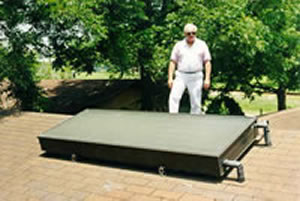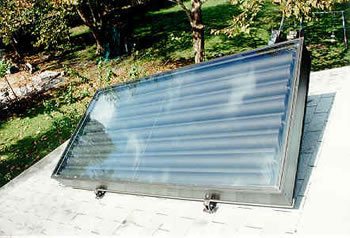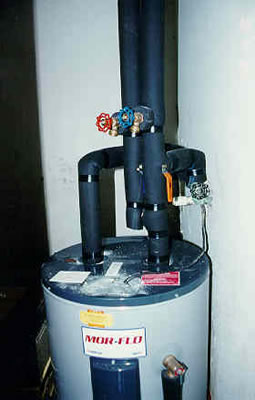
![]()
WHAT IS A SOLAR WATER HEATER?
A solar water heater uses the sun's energy to heat water. This was normally done by electricity. The use of a solar system reduces the use of electricity and in turn lowers electric bills. During cloudy and rainy days, the systems still use electricity as a back-up for providing hot water when the sun is not out. Solar systems have been in use in Florida since the 1930s. They are non-polluting and conserve conventional fuels such as oil and coal.
WHAT COMES WITH MY SOLAR SYSTEM?
A solar system includes a solar collector installed on the roof and a few valves installed in the water heater area. In some systems, a solar electric panel mounted next to the collector and pump installed in the water heater area are also included.
A homeowner's manual describing the type of system installed, how it works, a drawing of the system, and a parts list of the components used in the system is also provided at the time of the installation. There should also be a freeze protection information label attached to the storage tank describing the type of freeze protection provided with the system.
WHAT ABOUT RELIABILITY AND MAINTENANCE?
The solar system used in the Front Porch Sunshine program has been selected for its simplicity, reliability , long term performance, and for the fact that it has a minimal number of components.
HOW HOT CAN SOLAR HEATED WATER GET?
Hot water made from the solar collector can get very hot. The system chosen for this program incorporates a pre heat collector in which water is transferred from the solar collector to the standard water heater, thus mixing solar heated water with that in the standard water heater. This greatly reduces the possibility of introducing extremely hot water to the residential faucets.
DO SYSTEM OWNERS HAVE TO CHANGE THEIR HOT WATER USE HABITS TO USE A SOLAR WATER HEATER?
Not at all. What owners will find out with the solar system installed as part of the Front Porch program is that they will have even more hot water available than they had before the solar system was installed. This is because the installed solar system, be it a 30 or 40 gallon solar unit, doubles the amount of possible hot water available to the resident.
Just keep in mind that the water heated by the solar system is heated whenever the sun is shinning. No water is heated by the solar system at night and on overcast or rainy days. Nevertheless, even on cloudy days, the solar water heater still has the electric back-up heating element installed in the storage tank. This electric heating element will provide you back-up hot water during days when there is no sunshine.
To get the most out of the solar system (and save the most money from electric bills), it is best to use more hot water in the afternoon and early evening than in the morning. This allows the solar system to make hot water when the sun comes out.
HOW MUCH WILL I SAVE?
That all depends on how much hot water is used. A previous solar weatherization program indicated that on average any where from $15 to $20 per month was saved. In cases where a large amount of hot water is used throughout the day, the savings could double. So, once again, this all depends on how many people are in the house, how much hot water is used, etc.
WILL I HAVE TO DO ANYTHING ELSE ONCE THE SYSTEM IS INSTALLED?
The installed system has a parts and labor warranty. If there are any problem with the solar system, owners should contact the solar installer.
WHAT TYPE OF SOLAR SYSTEM IS INSTALLED?
There are many types of solar system available. The Front Porch Sunshine solar program has selected a simple and reliable one - the Integral Collector Storage system. Of course, this system has been approved by the Florida Solar Energy Center for use in Florida.
SOLAR SYSTEM TYPES
The following system has been selected for use in the Front Porch Sunshine solar program.
Integral Collector Storage (ICS) System
In this system, the collector and solar storage tank are combined. Figure 1 shows an ICS unit mounted to a south facing roof, while Figure 2 reveals the separate tubes that make up an ICS unit.

Figure 1

Figure 2
Since no pumps and controls are required, this system is considered a passive system. Potable water is heated and stored in a combined heat storage and collection unit. As hot water is used, service water pressure forces the water from the ICS unit to the standard electric water heater (Figure 3) in the house.

Figure 3
This system serves as a pre-heater to the standard water tank. This is a very simple system and requires no interaction on the part of the user. Overall, this system can be thought of as an extension of the current plumbing system. A schematic of the system is presented in Figure 4.
Freeze protection will be provided by thermal mass for the collector and thick piping insulation for exterior piping.

Figure 4
